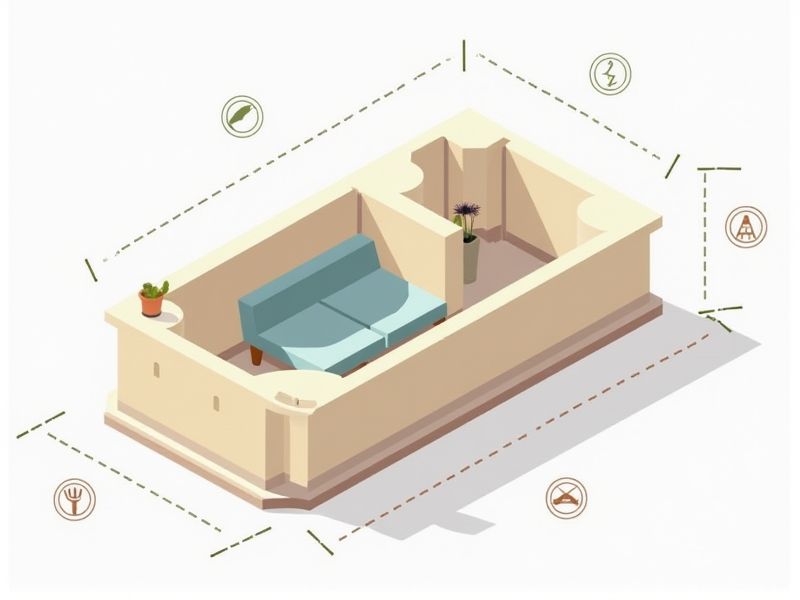
When planning a balcony, standard dimensions can help ensure functionality and comfort. Most residential balconies typically range from 3 to 5 feet (about 0.9 to 1.5 meters) in depth, providing enough space for basic furniture and movement. The length often depends on the width of the room it adjoins, but common lengths are between 6 and 12 feet (around 1.8 to 3.6 meters). Always check with local building codes and guidelines, as standards may vary depending on your location and the building type.
Minimum Depth Of 4 Feet For Usability
A balcony should have a minimum depth of 4 feet to ensure usability and comfort for occupants. This depth allows for adequate space for furniture, such as chairs or tables, enhancing the outdoor experience. A well-designed balcony with this dimension can accommodate multiple users comfortably, promoting social interactions. You can maximize your outdoor living area by adhering to this standard, thereby increasing your property's appeal and functionality.
Typical Width From 4 To 6 Feet
The typical width of a balcony ranges from 4 to 6 feet, providing sufficient space for outdoor furnishings and activities. This width allows you to comfortably accommodate elements like seating arrangements, planters, and outdoor decor. The standard depth also varies, but a minimum of 4 feet is ideal for creating an inviting atmosphere without compromising safety. When designing your balcony, considering these dimensions enhances usability while adding aesthetic value to your living space.
Height Of Railing At Least 36 Inches
Balcony safety standards mandate that railing heights must be a minimum of 36 inches to ensure user protection and prevent accidental falls. This height requirement is crucial for balconies situated in residential buildings, providing a secure boundary for occupants enjoying outdoor spaces. When designing or inspecting a balcony, you should also consider the spacing between balusters, which typically should not exceed 4 inches to inhibit small children from slipping through. Compliance with these regulations not only enhances safety but also contributes to the overall structural integrity of the balcony.
Load-Bearing Capacity
The load-bearing capacity of a balcony is critical for ensuring safety and structural integrity, typically ranging from 40 to 60 pounds per square foot, depending on local building codes. Accurate calculations must consider the materials used, such as reinforced concrete or steel, which significantly enhance strength and durability. Regular maintenance and inspections are essential for preserving this capacity over time, as wear and weather can degrade structural components. If you are planning to install or renovate a balcony, it's advisable to consult with a certified structural engineer to assess and optimize load-bearing specifications.
Proper Drainage Slope
A proper drainage slope on a balcony is essential to prevent water accumulation and potential structural damage. Ideally, the slope should be between 1% to 2%, directing water towards designated drainage points. This design not only enhances the longevity of the balcony but also minimizes maintenance issues associated with stagnant water. Ensuring your balcony meets these standards will significantly improve safety and comfort in your outdoor space.
Non-Slip Surface Materials
Non-slip surface materials for balconies play a crucial role in enhancing safety and preventing accidents. For instance, textured tiles or treated wood can reduce the likelihood of slips, with materials often rated with a coefficient of friction (COF) of 0.5 or higher for optimal safety. In addition, options like rubber decking or specialized coatings can improve durability while maintaining an aesthetically pleasing look. Investing in these materials can not only protect you and your guests but also increase the longevity of your outdoor space.
Compliance With Building Codes
Balcony standards emphasize strict adherence to building codes, which can vary by region but typically include load-bearing requirements, safety rail heights, and materials used. For instance, the International Building Code mandates that railings be at least 42 inches high for residential structures to prevent falls. Regular inspections and maintenance are crucial to ensure compliance, often conducted by certified professionals to assess structural integrity and safety features. Understanding these regulations is essential for homeowners and builders alike to create safe and durable balcony designs.
Privacy Considerations
A well-designed balcony prioritizes privacy, ensuring a serene outdoor experience. Privacy screens or plant barriers can effectively block sightlines from neighboring properties, which enhances comfort and seclusion. To achieve optimal privacy, consider materials such as bamboo or lattice that can also contribute aesthetically, with heights ranging from 5 to 8 feet. Choosing the right furniture arrangement, such as a sectional or a small table set, can also create defined spaces and foster an intimate atmosphere for relaxation.
Weather Resistance
Balconies built with weather resistance in mind typically include materials such as composite decking, aluminum railings, and waterproof membranes, ensuring longevity and durability. Advanced coatings and sealants provide protection against UV rays, rain, and temperature fluctuations, extending the lifespan of balcony surfaces. Regular maintenance, including inspections for cracks or leaks, is essential to preserve your investment and ensure safety. Incorporating drainage systems effectively directs water away, preventing damage from standing water and enhancing the structural integrity of the balcony.
Adequate Spacing For Furniture
Adequate spacing on a balcony enhances functionality and comfort, allowing for seamless movement and the optimal arrangement of furniture. An ideal clearance of at least 24 inches between furniture pieces ensures accessibility without compromising aesthetic appeal. For a small balcony, consider a compact two-seater set and a coffee table, maximizing use of available space while maintaining a relaxed atmosphere. By strategically placing plants and accessories, you can create an inviting environment that encourages outdoor enjoyment and social interaction.
